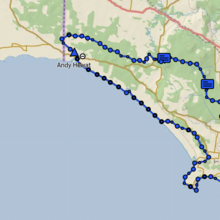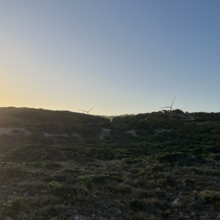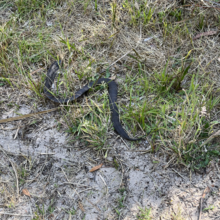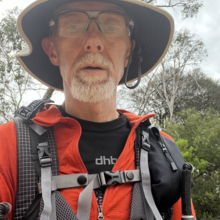Third time lucky.
This was my third attempt to complete the Great South West Walk (GSWW) in an unsupported fashion.
The GSWW is a 260km grand loop walking trail that goes from Portland to Nelson on the South Australia/Victoria border through inland forests and along the Glenelg River gorge and returns via the beaches and coastal paths with a detour inland via Mt Richmond (with an alternate option to continue on the beach). There are numerous hiker camp sites that offer basic shelter, water from a tank, and drop toilets. The only commercial resupply or food/drink retail options are at Portland, the village of Nelson around halfway - at the pub or service station (although the famous kiosk has sadly closed) and a café and restaurant at Bridgewater.
I had completed the loop 12 years ago in the self-supported style, essentially carrying all my supplies, but stopping at the Nelson kiosk for cold drinks and hot chips, in 58 hours 33 mins (2d 10h 33min). This time I wanted to go completely unsupported and attempt to break the male FKT, currently held by J. Taylor Bell at 4 days, 3 hours.
Leading up to this attempt, I had been carrying an ankle injury for 2 years which has limited my running to just fast hiking. So that’s what it would be this time around. No running. I made an attempt in December 2023 that ended with my ankle flaring up at Portland, about halfway, having started the loop in Nelson. Another attempt in March 2024 ended after about 50km on Mt Richmond with the ankle failing again. Would this third attempt suffer the same fate?
Starting in Nelson again and following the traditional anti-clockwise route, I left Simsons Landing boat ramp (right near where I was staying) at 8:18am on Tuesday 3rd December 2024. The relaxed start time meant the tide would be lower. Fully loaded with food for 3+ days and 1.5 litres of water, my pack weighed 8.7kgs (3.3kg base weight).
Day 1 was a great day on the beach. Mild weather with a steady tailwind and plenty of firm sand, made the pace good. Birdlife abounds with seagulls, pairs of oystercatchers, thousands of terns, and a few pairs of the endangered hooded plovers. As I approached the flocks of terns they would gently lift up as if co-ordinated and casually flap their wings just enough to hover above the waves before drifting back down as I passed. They were glorious to watch.
After a couple of hours, the track leaves the beach and weaves through the scrubby heathland parallel to the beach for a couple of kilometres. The trail here was overgrown and sometimes tricky to pick out in the sandy or rocky sections.
After some more beach the trail climbs back over the dunes to Monibeong Camp. A quick bottle refill from the bore water tap next to the toilets and I was off.
Monibeong 23.05km in 4:15hrs (12:34pm).
Back over the dunes and then onto the beach again. The tide was still out but threatening to come back in and steal my hard sand. Plenty more terns and oystercatchers scratching for pipis in the wet sand. And then I spotted what looked like a dead seal high up the beach. I approached cautiously, worried that it might actually be alive but injured. It was alive. It jumped up, startled out of slumber (which startled me), barked at me like a dog and then scampered down the beach and dived into the waves.
Following the course along the beach still, finally, the low sandy cliffs open and lead through the deep and steep loose sand dunes, carved with dune buggy tracks, to the Swan Lake campground. Bottles refilled from the shelter water tank. No one here.
Swan Lake 39.88km in 7:33hrs (3:52pm)
At this point the official GSWW offers a choice of continuing down the beach or climbing inland through the Mt Richmond National Park before dropping back to the coastal clifftops where the beach course links up with the inland route. I chose to follow the established FKT course that passes through all the GSWW campgrounds and therefore I continued on the inland route via Mt Richmond.
This leg also offers some of the best bushwalking, through the messmate forests and rolling grazing land. After leaving the beach and the massive sand dunes of Swan Lake, the trail now climbed steadily into rolling pine plantations before entering the Mount Richmond National Park. This was now a totally different ecosystem of rich native trees and wildlife. At one point, a koala startled me as it jumped from the trail, onto a tree that was far too small to support it. I’m not sure who got the bigger fright.
I was on high alert for snakes, but the trail had recently been cleared through here and was a good 2 metres wide, giving good vision of the ground on either side of the singletrack. However, I did see 2 snakes here and also a few echidnas. One of the snakes was not happy about my intrusion and came towards me with its head cocked menacingly. I have read that they are not coming after you, but rather you are blocking their preferred escape route. With this in mind, I slowly backed up and it quickly slithered past me into the brush.
I relevelled in the gently undulating forest with the characteristic loud creaking calls of the black cockatoos overhead, eventually climbing to the Mt Richmond picnic ground. I topped up my bottles from the tank here. One picnicker with a car. Then a long gentle downhill with some fire-trail sections led to the Tarragal camp site.
Tarragal 61.83km in 12:30hrs (8:48pm)
Another quick bottle fill-up here. There was a zipped-up tent pitched nearby so the hikers must already be in bed for the night. Camping kit was spread across the table in the shelter. I hoped there were no resident possums or mice or they would be having a party tonight!
From Tarragal the trail traverses wide open pastures with great views and a few stiles to climb. Darkness closed in and with my headlamp switched on, I descended through paddocks and across several stiles until hitting the short bitumen stretch of road into Bridgewater Lakes.
After passing the lake and just before hitting the clifftops again, the beach trail option re-joined the main trail. Somewhere around here my dodgy ankle flared up. This was not good. I tried ignoring it, to no avail. I was about 5 km from the next camp site, so I limped on, planning to reassess when I reached The Springs camp. The clifftop trail was sketchy in the dark, but I was moving slowly, giving me time to pick my way and avoid the steep drop-offs. I was pleased to finally descend the short spur trail into the camp.
The Springs 74.36km in 15:33hrs (11:51pm)
This was earlier than I had planned on stopping for the night, but with my ankle now flared up, I had no choice. I had some cold soaked noodles and threw down my bivvy and quilt for the night. I was fixated on my ankle and the fact that I still had 190 km to go. I knew it wasn’t feasible to finish now. I spent hours deliberating on how to get home from here in the morning. In my mind, the hike was over. Third time, not so lucky. It got cold and my clothes were still damp so I got uncomfortably cold to the point that I couldn’t sleep but not cold enough to motivate me to get up and put on my dry, warm thermals.
Eventually I did fall asleep but not for long as the day broke and it was judgement time. I pulled my runners on and walked around the camp. It wasn’t great, but the main dodgy tendon had settled and there was no significant pain. Reprieve! I was going on. There weren’t any options to get home from here, anyway. If it did get worse again, I was now heading towards Portland where I could organise a ride home, if necessary, later today.
Day 2 started at 6:34am. It was going to be a warm day. The views from the high clifftops were spectacular. Wind turbines with their sharp angular symmetry contrasted starkly against the ancient craggy geology and the rolling waves, smashing against the rocks far below. The trail hugs the clifftop all the way around Cape Bridgewater. On the eastern section there is a short sidewalk down to a viewing platform on the cliff face. I went down the few steps and checked out the seal colony, far below.
From here the trail gradually dropped back down to sea level, and I passed through the small hamlet of Cape Bridgwater that was coming to life with people buying coffees at the café on the beachfront. I hit the sand again for a long section of beach. Low tide again. Bonus. I had timed it perfectly with the tides.
After a kilometre or so, the trail climbed steeply off the beach and then undulated behind the sand dunes before reaching Trewalla camp. There were some school kids here with day packs, making lots of noise, as teenagers can do. Another quick bottle top-up and I was off.
Trewalla 91:45km in 26:03hrs (10:22am)
Not long after Trewalla the trail re-joins the beach again for a few kilometres. I passed a woman who was hiking the full loop but in sections, camping off trail, getting picked up and dropped off at the start and finish of each day. The multiple times I have been on this trail, I have encountered surprisingly few hikers doing the full loop.
Sadly, the end of this beach is heavily littered with washed up garbage, especially plastic bottles and heaps of rope (off boats). At one point there are actually 4 shipping containers washed up on the beach. You know, huge metal bulk shipping containers. This is a really remote section of beach and they would be an expensive and challenging salvage job. Ordinarily when walking the beaches, I pick up whatever waste that I can carry but there was far too much here to even make a dent in it and today I was on a mission.
It's a long steep climb up from the beach and then the trail traverses tea-tree scrub before hugging the clifftops around the promontory of Cape Nelson featuring the lighthouse. Not far after passing the lighthouse there’s a short detour of a few hundred metres into Mallee camp site. It was getting hot, so I spent some time here wetting down my head and arms and filling my bottles, including adding an extra litre of water in my Katadyn Be-Free bottle. (All the water I accessed on the hike was from tanks (except in Portland which has town water and Monibeong which has bore water) and I filtered it all, except in Portland.)
Mallee 106.9km in 29:24hrs (1:42pm)
Leaving Mallee, the trail passes another wind turbine farm. I could hear an incredibly loud crunching noise and discovered they were demolishing the blades of a wind turbine that had caught fire a few months prior. I spent a few minutes watching and was fascinated that they were crushing the blades while suspending them vertically between two cranes.
Still hugging the coast, the trail drops down into the appropriately named Enchanted Forest. This shady lush green forest was a cool haven from the heat of the afternoon. But it was only a kilometre of relief before climbing back to the cliff tops and into the afternoon heat.
The approach to Portland is up and down through a semi-industrial zone as you skirt around the huge Alcoa aluminium smelter. After crossing the railway line on the road bridge, you drop to the picturesque foreshore. It was now early evening but there were still plenty of people about. It was still pretty warm after a hot summer’s day. I found a good water source on the beach side of the skate park – a public drinking water bottle refilling station. Perfect, I refilled my bottles and had a good drink.
Continuing along the waterfront path, past the Information Centre which is the nominal start/finish of the GSWW, there are toilet facilities, including an outdoor shower for beach goers.
Portland 129.3km (halfway) in 35:14hrs (7:32pm)
The GSWW continues to hug the foreshore as it heads north, on what is the more popular start of the big loop in the counter-clockwise direction. Leaving the foreshore, I followed the GSWW red arrows which led me away from the ocean and away from the .gpx course I was following. I was soon on a path past the cemetery and again paralleling the coast but through residential streets. The markings got a little sketchy here. At the end of this path there was a green arrow but no red arrow, so I followed this green path (and the map), still headed north and out of Portland along the main highway. The green arrows then dropped me back onto Dutton Way (foreshore) where there was a red arrow again. Checking the map later, I found that this was definitely the official path, despite the paucity of red markers and not making any sense at the time. If I did it again, I would just stay on the waterfront, rather than taking this silly little detour through the back streets.
Darkness descended as I left the edge of town, and I began my second night. Headlight on. It was over a decade since I had done this part of the course and I had forgotten how much road is used as part of the trail. You follow the bitumen along Dutton Way for maybe 1.5km before turning inland. A few cars came past, and I was conscious of not wearing any reflective gear, so I moved well off the road each time.
The course then passes through some semi-private land (a public driveway that has been closed off and incorporated into the farm). I reached a closed farm gate and thought I was in the wrong place, especially since the cows/steers on the other side of the gate were eyeballing me in the dark. Then I saw the familiar red arrow pointing up this closed laneway and a stile to climb over beside the gate. (Note: the course markers are not reflective. This makes night navigation very challenging and led me to miss a few turns and spend a lot of time checking the map and gps.)
After crossing the main highway, I followed more bitumen roads in the dark, mindful of any cars in both directions. After a few kays, the trail turned back into the bush and it wasn’t much further to Cubby’s Camp. I planned to stop here for some food (more cold soaked noodles) and a sleep. This time I stripped off my damp top half and changed into my warm dry thermal top and polartec hoodie, before eating, cleaning my teeth and curling up in my bivvy. I went out like a light and was woken by the light of dawn.
Cubby’s Camp 150.4km in 40:05hrs (12:24am)
Day 3. After some cold soaked oats, I was back on the trail by 6:30am. Again, this was a much longer stop than I am used to taking, but I am also much older than the last time I completed one of these multi-day jaunts. I felt good and my ankle was behaving, but it was going to be a stinking hot day.
The trail now winds north through the Cobboboonee National Park until transitioning across in a westerly direction to join the Lower Glenelg National Park. It is fairly open forest with a clear wide path that is mostly flat and easy travelling. I made good time until the heat started creeping up on me.
I was doing the maths for a projected finish time. I was well inside the existing male unsupported FKT pace (over 4 days), but I really wanted to get in under 72hrs to make it a sub 3-day finish. That was possible if I went through the night, which I was sure I was capable of doing.
I knew there was a diversion coming up due to a foot bridge closure (Ralph’s Bridge), and eventually I came across the signage and turned onto the gravel road - Boiler Swamp Road. This detour triangulates the closed section of trail, eventually turning right onto Fish Hole Road. It adds a couple of kilometres to the course and has a couple of pinchy little hills but based on the permanent looking marker poles that are now in-situ, I suspect this detour will be in use for quite some time. It was not unpleasant hiking, but a couple of cars went past kicking up the dust, which surprised me, given we were in the middle of nowhere.
One bonus of the detour was a chance encounter with an emu and her chicks. Half a dozen little furry football-sized chicks with spindly legs and gangly necks, trotted off at pace behind their mum, as I turned the corner and surprised them.
A final right-hand turn onto Cut Out Dam Road for a few hundred metres and there was the signage leading me back onto the proper walking track. What I didn’t realise initially was that we were re-joining the trail north of Cut-Out Camp and had therefore completely bypassed it. After getting a few hundred metres back into the bush I realised this and stopped to reassess my water situation. It was hot, but I was confident I had enough to get me to the next camp (less than 9km away), so there was no need to back-track and seek out the by-passed camp. (Note: this highlighted the importance of checking the Parks Vic website for latest trail updates where I was initially alerted to this detour, but I failed to appreciate the actual course implications for water access.)
The heat was kicking in, but I was still making good time and reached Cobboboonee camp shortly after crossing Cobboboonee Road. A quick top up of my bottles and a good drink and I was on my way.
Cobboboonee 180.1km in 51:29hrs (11:48am)
The trail continued to be easy travelling, but the heat was becoming oppressive. I adjusted and slowed the pace accordingly. There was some intermittent shade, but even the light breeze was hot and not helping. At one point I realised I was getting a little lightheaded, possibly just fatigue, but likely getting heat stress as well. I found some good shade and threw down my foam mat and had a dirt nap. I went straight to sleep without any alarm, confident I would wake when refreshed.
About 20mins later I was awake and feeling much better. I pressed on to Fitzroy camp, where I took a decent rest in the shade of the shelter. I “cooked” some cold soaked noodles by placing them in the sun for 10minutes. I ate, rested, drank and refilled my bottles. I took nearly an hour resting with my feet up, allowing the heat of the day to dissipate and my system to cool down and reset, before heading back out. (Note: my garmin recorded the max heat at 42*C so it was definitely hot out there.)
Fitzroy 193.1km in 55:09hrs (3:28pm and left at 4:26pm)
I felt much better, and the sting had now gone out of the heat. I started doing the maths again in my head. Despite the accumulative fatigue, I was easily dividing and multiplying hours and kilometres in my head and knew that 72hrs was still achievable but would take some work overnight.
The trail emerged from the forest and ran along a fence line with rolling pastures abutting the forest. In the late afternoon sun, a huge mob of kangaroos were gazing peacefully. As I approached, they started scattering, some diving under the fence and disappearing into the forest in front of me. Others bounding off over the horizon. A huge dominant male stood tall and alone until all the others were out of sight, watching me approach. After making his point (this was his territory) he turned and bounded off as well. I don’t care how many roos you’ve seen, if you don’t marvel at the sight of a roo in full flight, then you have no appreciation of athletic majesty, power and grace embodied in their amazing biomechanics.
Crossing the main Winnap-Nelson Road marked a huge milestone, meaning I was now on the final leg through the Lower Glenelg National Park. I had driven past this point many times and it signified entering the home stretch. The trail drops quickly down to Moleside camp on the Glenelg River. Despite having good road access here, there were no car campers, just one hiker who greeted me and walked up to the shelter with me. She was hiking in the opposite direction but camping here for the night. Having hiked the loop in the counter-clockwise direction previously and loved it so much she had come back to hike it in the reverse (clockwise) direction.
Moleside 214.9km in 60:29 (8:48pm)
It was now dusk, so I donned my headlamp, filled my bottles, wished the hiker all the best for the rest of her journey and was on my way.
The trail now largely hugs the Glenelg River all the way back to Nelson, with periodic deviations and undulations. For a while it followed a broad, flat, straight benched trail. I spotted a couple of small frogs on the path and then I had to concentrate not to step on any of them as they blended in so well with the leaf litter.
I was still working the maths for a sub-72hr finish, but I was bleeding time, and my buffer was disappearing. There were a few trees down across the path, that kept breaking my momentum. Then I missed a turn when the trail joined the access road to Saunders Landing before branching off again. And then in the dark, I struggled to find the exit for the trail out of Pritchard’s camp. If the markers were reflective this probably wouldn’t be such a challenge at night, but the trail is not really set-up with night hiking in mind.
Next stop was Battersbys, another empty camp. A quick water top-up.
Battersbys 234.3 in 64:51hrs (1:09am)
I was starting to jog a little to pick up the pace. I figured if my ankle flared up now, I was close enough to be able to still just limp to the finish. Through Forest Camp, Murrells, and past Sapling Creek, without stopping. And finally, at Pattersons camp and my last chance to top up water with just 17km to go.
Pattersons 248.0km in 67:49hrs (4:08am)
With my bottles full, I was pushing hard now and actually running when the trail allowed. The race for sub 72hrs was on. I have a lot of experience from my ultra-running of chasing cut-offs and closing out tight finishes.
But then I drank some of my water. I was out of Tailwind, so it was now unflavoured. It tasted foul. I had filtered it and it had come out of the tank clear and odorless, so I was confident it probably wasn’t going to make me sick. But it tasted brackish, and I couldn’t drink it so despite now running, I only took a few sips over the next 3-hours, just enough to quell the worst of my thirst.
As the light started streaking the sky, I kept pushing hard, running whenever the trail opened up and when it wasn’t chopped up too badly by the echidna holes! The Glenelg River is a wide river that meanders through a deep limestone-walled gorge and presents spectacular vistas. At one point, the trail crosses into South Australia across the invisible border while following the winding river before crossing unceremoniously back into Victoria.
Finally, the last camp was reached: Simsons Landing camp. I didn’t stop, knowing I was less than a kilometre from my start/finish line.
Simsons Landing camp 266.3km in 71:31hrs
This part of the trail is very familiar to me, I was nearly home. I soaked in the surroundings, basking in the knowledge that I was not only going to finish the full loop, but I was also going to break the 72hr mark. Finally, the trail dropped down to the small picnic area and the popular boat ramp at Simsons Landing proper. Job done. Whoot!
Simsons Landing boat ramp 267.05km in 71:41:06hrs (7:59am)
Footnote:
The GSWW is a distinctive loop trail that traverses several different ecological zones delivering a diverse experience for the hiker/runner. The rich biodiversity includes lots of wildlife. I saw 3 snakes (2 were Tiger snakes, not sure about the third), a handful of echidnas (and a thousand potholes dug by them!), 2 frogs, an abundance of birdlife including hooded plovers on the beach and yellow tail black cockatoos in the forest, 3 koalas (and heard many more grunting in the trees), possums, a seal plus the seal colony (in the distance), an emu with chicks, mobs of kangaroos and a gazillion wallabies (who frequently startled me by bolting/crashing through the brush, especially at night). I call the GSWW the undiscovered jewel of trails. I have done the full loop twice (2012 and 2024) and run/hiked lots of it many other times, and I never tire of it.
Trip notes:
- The shelters are very basic but have good camping options, are well spaced and provide drop toilets and tank or bore water (I still filtered it through a Katadyn Be Free).
- There are accommodation and food/beverage options at Portland and to a much lesser extent the small village of Nelson. Note the popular Nelson Kiosk which is on the course is now permanently closed. A short diversion to the Nelson service station provides some basic supplies and fast food. The local pub does meals and now also early morning coffees (since the kiosk closed). There are also some accommodation and food options at Cape Bridgewater.
- Check the tides for the beach sections when planning. It would be possible to traverse most of the beaches on higher tides, but it would be really tough travelling on the soft, loose sand.
- I have started at both Portland and Nelson. I prefer the Nelson option, it gives more certainty with timing of the tides, you get the long flat beaches under your belt while you are fresh (and if unsupported – when your pack is heaviest).
- The White Sands camp off the beach between Nelson and Monibeong still shows on old maps but no longer exists.
- While the course is easy to navigate, the trail markers (small dark red triangles) can be tricky to spot and apart from a handful, they are not reflective, making them impossible to see at night. As always, passing through the towns can be the trickiest part to route find.
- My <72hr time, while beating the old male unsupported time, is still quite achievable. I hiked it all apart from the last 30km, I lost time to the heat and stopped for over 6-hours on 2 nights.
Some of these lesser known FKT courses are not so much about how fast you are, but more about how much discomfort you can tolerate and how much sleep deprivation you can function with. Stay safe and enjoy!












